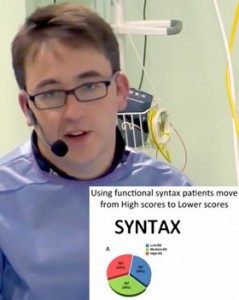
Dr. Justin Davies discusses value of using physiology-guided PCI
If you’ve been wondering what iFR (Instant wave-Free Ratio) is, how it works, how it compares to FFR (Fractional Flow Reserve) and, most importantly, how it affects clinical outcomes, then click here to register for a free, online, interactive live case being done on Monday, April 13, 2:30pm-3:30pm London Time, 9:30am-10:30am New York Time).
Interactive: that means you can ask questions!
Dr. Justin E Davies, interventional cardiologist at Imperial College NHS Trust, and developer of iFR, will be performing and guiding the worldwide audience through a live complex PCI multivessel case, using physiology to guide his procedure.
Why is physiology important in multivessel complex cases? Well normally a patient presenting with blockages in more than one vessel is assessed to have a higher SYNTAX score and should be considered for CABG (coronary artery bypass graft surgery) instead of PCI. But what if the SYNTAX score could be lowered by determining that one or more of these blockages is, in fact, not significant and does not need to be revascularized with a stent, or with a bypass. That is exactly what functional measurement of the flow through the arteries can show. The DEFER, FAME and FAME 2 trials have demonstrated that deferred stenting for physiologically insignificant blockages can not only save time and money; it also can improve outcomes.
We’ve written extensively about these issues over the years. You can find these articles in Angioplasty.Org’s Intravascular Guidance Center, including an interview with Dr. Davies.
Where iFR differs from FFR is that it does not requires the use of a vasodilator, such as adenosine, to achieve maximal hyperemia – this feature translates to quicker readings, especially of serial lesions…but you’ll find out about all of this tomorrow, assuming you sign up for the course!
You’ll also: (1) learn how to select patients suitable for PCI using the latest physiological techniques; (2) attain first hand knowledge in iFR and iFR Scout; (3) see how Sync-Vision can demonstrate co-registration between IVUS and Angiography; and (4) understand how clinical trial evidence is evolving to increase appropriate PCI use in patients with complex and multi-vessel disease.
The course itself is being produced by Radcliffe Cardiology and sponsored by Volcano, which became a division of Philips Healthcare in January. As for learning cutting edge techniques, the iFR Scout pullback software just received CE Mark approval last month (U.S. approval is pending). For those who cannot watch the case live, it will be archived, but you still will need to register — but, alas, unless you have that time machine, you won’t be able to ask questions….
I’ll also be online, watching, and live-tweeting the case. Follow me at @angioplastyorg.



